The Three Musketeers
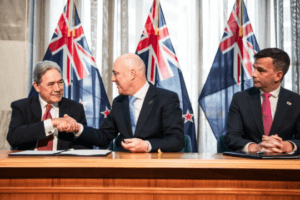
The Three Musketeers
(The Property Implications of the Coalition Agreements)
Before you chortle at the idea of Luxon, Peters and Seymour galloping in on stallions, dressed in tights and brandishing cutlasses, bear with me….it might not be as fantastical as you think.
First let’s refresh ourselves on the fictional story. The Musketeers were formally known as the Musketeers of the Guard – essentially an elite fighting force of the French Royalty – that part is true. The story about three Musketeers (Arthos, Porthos and Aramis) campaigning for justice is fictional. Then there was D’Artagnan – a youth desperate to be a musketeer who was ‘adopted’ by the three. They spent their lives fighting for what they believed, and the story is essentially about their adventures.
All three party leaders in the 54th New Zealand Government hold deep beliefs that they have long been fighting for. Peters uses his cutlass to poke journalists while laughing infectiously – but his drama belies a strong desire to hold the government to account. Seymour wants to use his cutlass to cut red tape and point people to the right. And Luxon? Well, Luxon has believed for many years that one day he would be prime minister. He will restore law and order, he will solve the educational ills, he will make our hospital system world class…and his cutlass shall be used to… time will tell – but in the interim I am sure he will whip it back and forth and make loud swishing noises.
But what are the specific causes they are fighting for, what do the coalition agreements tell us they are going to do about it and what will the impact be on us commoners who simply own a property or two? OK, so technically that last part might be an oxymoron.
The Social Battles
Here is my view of the key societal battles ahead:
- Cost of living
That was an easy one for the opposition to campaign on because it impacts everyone – the pain is real. Talk to any account manager at one of the banks and they will tell you that a lot of clients are really feeling the pinch…businesses are running out of cashflow/ capital runway. - Ability to buy property
How can you buy a property if the banks won’t/ can’t lend you any money? - Ability to rent a property
How can you rent a property if there simply isn’t enough property to rent…i.e. if the number of people renting is greater than the number of houses available? - Everything else
Hospitals, education, law and order. The really easy issues to solve…!
What do the Coalition Agreements say they will do about it?
A note before we delve in. There isn’t one coalition agreement, but two. One between National and Act and one between National and NZ First. That said, there is a lot of common ground between the two. We will look at the relevant parts of the agreements. It should also be noted that the agreements differentiate between things that must be done and things that are to be ‘explore, investigated or considered’.
We’ll focus on the ‘must do’s’.
Tax
- Roll back interest deductibility. Sure, National said they would do it as well, but what Seymour has negotiated is a faster roll back:
- 60% deductibility in 23/24
- 80% deductibility in 24/25, and
- 100% deductibility in 25/26
- Repeal the clean car discount.
- Foreign buyer ban won’t be repealed.
Employment
- 90-day trial period for employees of all companies. It has been available only for companies with 19 employees or less.
Immigration
- Increase the number of RSE workers (seasonal agricultural workers) that can come into the country.
Monetary Policy
- Removal of the dual mandate for the RBNZ – i.e. no longer has to support maximum sustainable employment.
Tenancy
- 90-day notice without giving a reason or applying to the tenancy tribunal.
- Return tenants’ notice period to 21 days and landlords to 42 if the tenant wants to move or landlord wants to sell a property.
- Introduce “pet bonds” to make it easier for tenants to have pets in rental properties.
Infrastructure and Housing
- Medium Density Residential Standards (MDRS) optional for councils, and to consider sharing a portion of GST collected on new residential builds with councils.
- Replace the Resource Management Act 1991 with new resource management laws premised on the enjoyment of property rights as a guiding principle.
- Legislate to make the MDRS optional for councils, with the need for councils to ratify any use of MDRS, including existing zones.
- Institute long-term city and regional infrastructure deals, allowing PPPs, tolling and value capture rating to fund infrastructure.
- National infrastructure agency.
- Alternative 4 lane highway around the Brynderwyns (SH1 to Whangarei).
Fiscal Policy
- Deliver savings in public sector spending by reducing non-essential back-office functions, with expenditure reduction targets to be set for each agency, informed by the increase in back-office head count at that agency since 2017.
Here are some of National’s key policies:
- The Brightline test will be brought back to 2 years.
- A bunch of social policies – If they work, then people will become better educated, people will be safer and people will be healthier. All of that means people will be more able to work and be better at it.
What are the Impacts of these Policies on Social Problems and Property?
The Conundrum
Before we delve into how these policies might help, let’s recap on the conundrum we face with these challenges.
- Higher interest rates mean it is harder to get a mortgage, which means less people will buy property, which means builders will build less houses, which means there are less houses relative to the population as the population grows.
- Lack of interest deductibility means it is less affordable to buy investment property, which means less people will buy property which means builders will build less houses, which means there are less houses relative to the population as the population grows.
- The inability to remove problem tenants means it is less attractive to buy investment property, which means less people will buy property, which means builders will build less houses, which means there are less houses relative to the population as the population grows.
- The higher the cost of holding a property due to higher interest rates means that even if you can get a mortgage, you may not want to because the shortfall feels too large and therefore …I think you know the rest.
While the RBNZ has been trying to reduce inflation by driving the OCR higher, the previous government was endeavouring to drive greater ‘balance’ between renter and landlord through legislation that they believed would bring greater protection to the renter. Unfortunately, both these initiatives had unintended (yet we would argue quite predictable) detrimental consequences for the renter. If you can’t afford to hold investment property either because you can’t get a mortgage, can’t afford one, or can’t tolerate the massive rental arrears that build up because you can’t evict your tenant for non-payment…then you will simply not buy or continue to hold property. It is no wonder that we are now reading stories in the press of rents jumping up rapidly and people not being able to find properties.
The graph below supports this… look at the trend. Consents have dropped dramatically. They have to. Builders simply won’t get development finance if they can’t sell properties. So, they don’t bother getting a consent. However, keep in mind a consent does not equal a built property. You can’t live in a consent. How many of the consents are not currently getting built? But that is only ½ the story. Demand is the other half of the story.
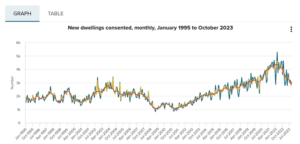
You wouldn’t worry about plummeting supply if demand was falling at the same rate. That is not the case. Annual population growth is as high as it has ever been. You could argue that’s not as bad as it looks (see graph below) because the average growth from 2020 to 2023 was about 50k because of the population shrinkage in 2021 and 2022. That is a true statement. However, the growth in the year to Sept 2023 was 118k, so we are heading towards a record setting year for the year to June 2024. Also, if we look at the breakdown of the movement, 70,000 kiwis left in the year to 30 June 2023. This is probably a catch up from people who had to delay plans to head offshore because of COVID. It is quite possible this out-flow will recede while immigration continues to charge ahead at current levels. If that is the case, then we could see net migration increase further!
Finally, if we add to this the coalition policy to increase the number of seasonal workers then population will increase even further.
The key thing to note is that the trend lines are going in opposite directions. We have a growing population yet a shrinking rate of housing construction. That tells me we have a major housing crisis looming if it hasn’t arrived already.
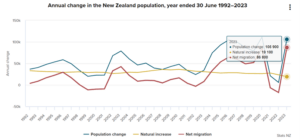
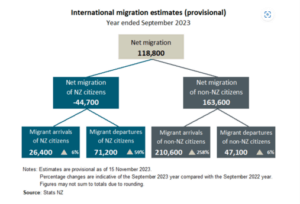
Also note that there is an almost direct correlation between net migration and house sales volumes, as can be seen from the graph below. Although house sales volumes are currently bucking the trend – they aren’t lifting in response to increased population. That is a problem. This certainly supports the above data and assertion we have a looming housing crisis.
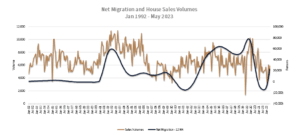
So, we come back to the policies of our three musketeers – is it enough? Will their policy changes be enough to fight off the housing crisis?
Before we answer that, we need to introduce D’Artagnan, played by none other than Adrian Orr. D’Artagnan wasn’t part of the musketeers – he just worked with them. Adrian Orr doesn’t set policy, but he has weapons at his disposal. And this is our conundrum, Orr has a big influence on interest rates. While interest rates are high it is more difficult to borrow because it makes it harder to meet serviceability criteria for a residential mortgage and harder to meet interest cover ratios for commercial property. If tenancy law has become more attractive to landlords and the tax bill has become a bit lighter, but you still can’t get a mortgage, then you still won’t be buying property.
So, what is going to happen?
The Likely Outcome…?
It’s pretty simple. When demand exceeds supply then prices go up. Having been in this business for 15 years, and personally investing in property for many years more than that, we know that consumer and business confidence has a big part to play. Perhaps anecdotal, but we talked to hundreds of our clients and investors leading up to the election and the most common comment was ‘we just want to wait and see what happens with the election’.
We now have a government – we have certainty – and their policies are more property investor friendly. On this basis alone we’d expect prices to start rising. And that is what is happening. Though it’s hard to get a mortgage, that hasn’t stopped property prices bottoming out and starting to climb as can be seen in the graphs below. Auckland is particularly strong. This will be driven by the people who have the means to buy, starting to regain confidence and get on with making their planned purchases that were deferred due to nervousness about the state of the economy and society.
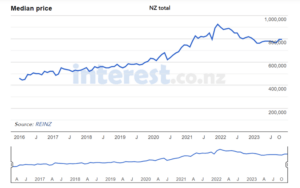

But the real boom in house sales and thus price growth will not happen until it is easier to get a mortgage. That won’t happen until interest rates fall. And that won’t happen until D’Artagnan is happy with inflation.
Our market commentary this time last year was entitled Sex, Drugs, and Inflation. We asserted that the back of inflation had been broken and 2023 would be a matter of working through it. I think we got that pretty right – the graph below shows that inflation is on its way back down. While it’s not where the RBNZ must have it, the trend is the most important thing. Additionally, there is a lot of cost-of-living pain in the average household that is yet to be reported.
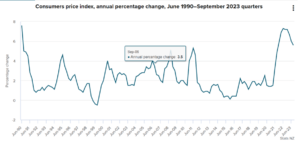
The challenge the three musketeers and D’Artagnan face is that interest rates must come back down to allow people to buy so that more houses can be built so we can get people into homes. However, if Orr reduces interest rates there is a risk that people then feel richer, consumer spend lifts and then inflation soars.
Is that why Orr at the latest OCR announcement ‘spooked’ NZ into being worried about another OCR hike if we don’t behave? If you knew you would have to start bringing the OCR back down in 2024 to make living more affordable and allow people to get on with investing and buying…wouldn’t you do everything within your power to talk the market down? Is that just a bit of sabre, or should I say, ‘cutlass rattling’? I think so.
I think it’s a bit like Santa Claus. When my kids were little, I told them that Santa Claus wouldn’t come if they were naughty and I’d see fear and panic in their eyes, perhaps even a little tear. Now I have three teenagers, and when I say that they look at me sideways and assess how far they can push the envelope more their requested Airpods are at risk.
So here is what I think will happen:
- Population and thus demand for housing will continue to grow at breakneck speed.
- NZ will come back from holiday refreshed and rearing to get stuck into their new years resolutions which will include crack on with their property buying plans. Why? Because they feel more confident, because we have a government, and that government is more supportive of property investors. And we will believe that National will start to fix health and law and order and education. They will have 6 – 12 months grace period – if they haven’t made inroads by then, then enthusiasm may wane. But in the interim it is likely people will feel positive.
- Adrian Orr will be forced to start reducing the OCR sometime in 2024 to make it life more affordable for existing mortgage holders. And…to free up some of the pent-up house buying demand.
- To counter the reduced OCR, Orr may start using the DTI (debt to income) tool. This week we saw an article in the NZ Herald about DTIs. That is the start of the RBNZ starting to socialise DTIs – getting us ready. This, in conjunction with LVR restrictions will be used regulate how much demand flow gets let out of the dam, so to speak. You can think about property demand like water in a dam. It gets held back by interest rates, LVR restrictions and now DTI. We’d argue that some of that demand must be released or else the pastures downstream won’t get watered, and the crops will die. If Orr doesn’t make it more affordable to live and make it more possible to buy property, he will quite literally starve people and leave them shivering on the roadside. But he will want to regulate the flow and he’ll use LVR restrictions and DTIs to do that.
- And therefore…. prices will rise markedly as interest rates drop.
To Conclude
Comparing our political leaders with the Three Musketeers and Adrian Orr to d’Artagnan is a bit silly. Predicting that property prices will go up could also be seen as a bit silly, but hopefully the analogy and analysis has given you a way to think about the property market and provided a couple of nuggets of truth for you to ponder over the break.
We hope you all have a great Christmas. There is a new French movie out on the Musketeers called The Three Musketeers: D’Artagnan. I might give it watch over the holidays.
No better way to kickstart the new year than with the right plan. We are offering limited spaces for our Property Planning Sessions with Simon Paris, GM of Investor Relations at Erskine Owen. If you have always thought about investing more in property, but just never seem to get around to it…then this session could dramatically change your future. We will show you what specific steps you need to take to achieve your long-term financial goals.
Erskine Owen, provides a comprehensive service that includes financial planning, mortgage brokering, investment property sourcing, and management.


